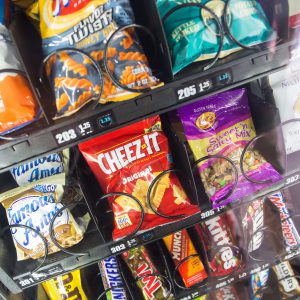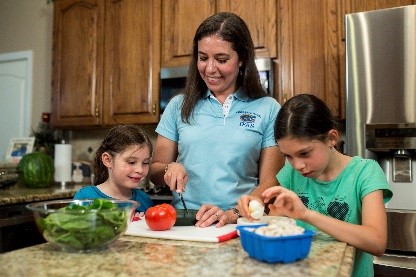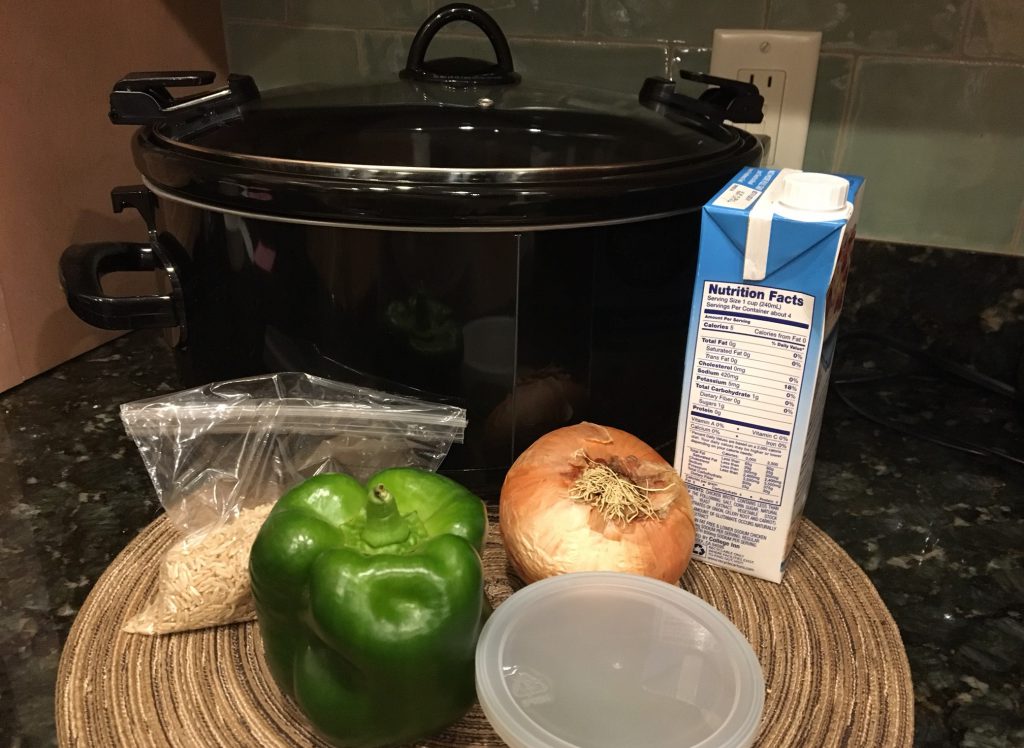
by Samantha Kennedy | Jan 26, 2018

Convenient prepackaged snacks such as these can add extra salt, fat, and sugar to your diet. (Photo credit: Lyon Duong, UF/IFAS)
Snacks are an important part of a healthy, balanced diet. But not all snacks are created equal. All too often, we reach for the salty, sugary, prepackaged snacks like chips, cookies, and other sweets because they’re convenient and easy to grab and go. But be careful! Even if the portion size is small, these types of snacks can contain a lot of unnecessary calories. Even snacks marketed as healthy, such as trail mix, granola bars, and protein bars can contain added sugars and fats.
The Nutrition Facts label contains a wealth of information…if you know what you’re looking for. The number of total calories and calories from fat are listed at the top of the label. Ideally, snacks should contain less than 200 calories. Also, if the number of calories from fat is greater than 30 percent of the total calories, it may not be the best choice.
One of the biggest pitfalls when it comes to snacking is overeating. Snacks are meant to provide sustained energy to help keep blood sugar levels even throughout the day and to supplement calories and nutrients not provided by meals. They are not meant to be mini meals, so be careful of portion size. Check the label for what constitutes one serving and stick to it.
Prepare your own snacks instead of buying prepackaged convenience foods. Cut up fruits and vegetables and store them in snack bags that can be easily toted in your purse or bag. Keep small containers of nuts – preferably unsalted or lightly salted – in your desk or car for a high-protein on-the-go snack.
There are plenty of easy, delicious, and healthy snack choices from each food group. Here are a few examples:
Fruits: Bananas, melon chunks, apple slices, and orange wedges
Vegetables: Broccoli florets, carrot sticks, sugar snap peas, and zucchini sticks
Grains: Mini rice cakes, whole grain crackers, plain popcorn, and unsalted pretzels
Proteins: Nuts (e.g. walnuts, almonds, and pistachios), hard-boiled eggs, peanut butter, and pumpkin seeds
Dairy: Low-fat yogurt, string cheese, milk, and cottage cheese
Need more help with snacking healthy? Here are some terrific resources from the University of Florida IFAS:
“Healthy Eating: Sixteen Savory Snacks” – https://edis.ifas.ufl.edu/pdffiles/FY/FY70500.pdf
“Healthy Eating: Smart Snacking” – http://edis.ifas.ufl.edu/pdffiles/FY/FY70800.pdf
“Healthy Snacking” – http://edis.ifas.ufl.edu/pdffiles/FM/FM43900.pdf
“Raising Healthy Children: Promoting a Positive Feeding Experience” – http://edis.ifas.ufl.edu/pdffiles/FY/FY139700.pdf
by Angela Hinkle | Nov 20, 2017

Dine In Day, December 3rd, is a day to set aside and share a nutritious meal with family, friends, and colleagues and have good conversation. Dining In at home together really does make a difference in the lives of our families – biological or otherwise. Sharing a meal is so fundamental to the human experience that sometimes we take this simple task for granted. Dining In at home together decreases our families’ chance of being overweight or obese. It improves our families’ relationships. We save money and eat healthier when Dining In.
Not enough time, busy schedules, and too much stress, however, might make this seemingly impossible for many families.
So here are some tips that might make Dining In a little easier for you and your family from AAFCS (American Association of Family & Consumer Sciences).
- Make family meals a priority and agree upon a schedule.
- Try to have regular family meals two to three times per week.
- If dinnertime doesn’t work, have family breakfasts or snacks.
- Keep meals simple. Slow cookers save time in the evening!
- Double recipes and freeze food for a second meal.
- Set aside 30 minutes on the weekend for meal planning.
- Make family meals fun and include children in food preparation. How about having breakfast for dinner?
- Discuss neutral or positive topics at the table. Stumped for what to talk about? Try this conversation starter: “What fun thing did you do today?”
- Eliminate distractions like TV and cell phones.
- Eat slowly and enjoy your time as a family!

Dine In with Family
To help you make the pledge to Dine In with your family December 3rd, go to http://www.aafcs.org/fcsday/commit-to-dining-in/fcs-day-sign-up and make your very easy commitment today. After that, see how many more Dine In days you can make with your family.
To learn more about the Benefits of Family Meals, read http://edis.ifas.ufl.edu/pdffiles/FY/FY136200.pdf
by Pam Allen | Nov 18, 2017

Slow Cooking
Photo credit: Pamela Allen
With the weather changing and cooler temperatures on the way, get out the slow cooker for simmering soups and stews that will be waiting for you when you get home. Slow cookers are popular and allow us the convenience of prepping ahead of time and having a hot cooked dish when we get home from a long day of work. The advantage of slow cooking is to set it and then forget it. Stirring is not usually required and remember to keep the lid on as the food simmers. Today’s slow cookers are food safe and keep food at a safe temperature of 170˚F to 280˚F. The low heat allows use of less expensive and leaner cuts of meat as the slow cooking will tenderize and shrink less.
Cooking with a slow cooker means planning ahead but the payoff is a great meal. You can prepare all the ingredients the night before like chopping of vegetables, cutting up the meat and gathering the other items and have them handy for the next morning. Remember to refrigerate all items needing refrigerating until it is time to place in the slow cooker.
Here are some tips or using your slow cooker safely and economically.
- Start with a clean cooker and utensils. Always use a clean work area and make sure to wash your hands during the preparation.
- Keep perishables refrigerated until ready to use. Store meat and vegetables separately if preparing ahead of time.
- Always thaw meat or poultry before putting it into a slow cooker. If frozen pieces are used, they will not reach 140° quick enough and could possibly result in a foodborne illness.
- Keep in mind to not lift the lid unnecessarily during the cooking cycle. Each time the lid is raised, the internal temperature drops 10 to 15 degrees and the cooking process is slowed by 30 minutes.
- After enjoying your meal, do not leave cooked food to cool down in the cooker. Store leftovers in shallow containers and refrigerate immediately.
- Do not overload the slow cooker. Fill to a minimum of 1/2 full and a maximum of 2/3 full.
Try some of these favorite recipes to get you started:
Hamburger Soup
2 pounds lean ground beef, browned and drained
2 teaspoons dried basil
2 teaspoons dried oregano
2 teaspoons garlic powder
5-6 cups tomato juice
1 cup stewed tomatoes
1 large onion, chopped
2 cups chopped celery
1 cup sliced carrots
2 cups sliced green beans, fresh or frozen
1 tablespoon Worcestershire sauce
salt & pepper to taste
Place browned meat in slow cooker. Add all remaining ingredients and stir to mix well. Cover and cook on LOW for at least 5 hours. Makes 6 servings.
Old-Fashioned Chicken & Rice
2½ cups chicken broth
1½ pounds boneless, skinless chicken breast meat, cut into 1-inch pieces or strips
1½ cups long grain rice, uncooked
¼ cup fresh parsley, minced or
1 tablespoon dried parsley
1 cup chopped onion
6 garlic cloves, minced
1 small red bell pepper, cut into thin strips
1 (6-ounce) jar sliced mushrooms, undrained
¼ teaspoon poultry seasoning
Combine all ingredients in slow cooker. Cover and cook on HIGH for 3-4 hours, or until chicken is no longer pink and rice is plumped tender.
Favorite Beef Stew
3 carrots, sliced
3 potatoes, cut in 1-inch cubes
2 pounds beef stew meat, cut in 1-inch cubes
1 cup beef broth
1 teaspoon Worcestershire sauce
1 clove garlic, minced
1 bay leaf
salt to taste
Combine all ingredients in slow cooker in order listed. Stir just enough to mix seasonings throughout. Cover and cook on LOW for 10-12 hours, or on HIGH for 5-6 hours. Makes 6-8 servings.

by Angela Hinkle | Oct 27, 2017

Peanut Butter Challenge Champion
Picture credit: Angela Hinkle
So you say you never win anything? Taking the Peanut Butter Challenge is a competition you’re guaranteed to win.
You can help feed the hungry in Florida’s Panhandle this year by donating peanut butter during the annual Peanut Butter Challenge, coordinated by UF/IFAS Extension. Thanks to a partnership between UF/IFAS Extension and the Florida Peanut Producers Association, food pantries from Pensacola to Monticello will receive thousands of jars of donated peanut butter this December.
From October 1 through November 22, you can donate unopened jars of peanut butter at your UF/IFAS Extension county office. Since 2012, UF/IFAS Extension faculty and volunteers have collected jars of peanut butter from residents, volunteer groups, and businesses in 16 northwest Florida counties. Last year, UF/IFAS Extension county offices received 3,236 jars of peanut butter! In addition to these donations, the Florida Peanut Produces Association also contributes, supplying more than 3,000 jars each year to the Challenge.
We hope to surpass last year’s total! This year, citizens throughout the Florida Panhandle counties are asked to help by donating peanut butter and becoming Peanut Butter Challenge Champions.
“The Peanut Butter Challenge not only raises awareness about the important contribution of North Florida’s peanut growers to the state peanut industry, but also helps provide a healthy, locally produced product to food-insecure families in northwest Florida,” said Libbie Johnson, Agricultural Agent in Escambia County.
Why peanut butter? Peanut butter is the most requested item at food pantries. See https://youtu.be/fPFvSgzmM3Y to learn more. A serving of peanut butter is loaded with protein, vitamins, minerals, fiber, and “good” fats. Peanut butter is a shelf-stable item – meaning it does not have to be heated or refrigerated. And people really like the taste.
How do you become a Peanut Butter Challenge Champion? Look for peanut butter BOGOs and other discounted sales at your local stores. Keep a jar for yourself and give the other unopened jar(s) to the Peanut Butter Challenge.
Voila! Everyone’s a winner! And you may proudly say, “I am a Peanut Butter Challenge Champion!”
by Amy Mullins, PhD, RDN | Oct 26, 2017
 We all have family traditions that make our holiday celebrations special. From your great-great-grandma’s sweet potato casserole or pecan pie, to your mother-in-law’s sausage stuffing or decadent plum pudding, there’s one thing that always seems to be a common factor among traditional holiday dishes: a massive amount of, fat, sugar, salt, and calories!
We all have family traditions that make our holiday celebrations special. From your great-great-grandma’s sweet potato casserole or pecan pie, to your mother-in-law’s sausage stuffing or decadent plum pudding, there’s one thing that always seems to be a common factor among traditional holiday dishes: a massive amount of, fat, sugar, salt, and calories!
It’s not only a single meal but rather an entire season of parties, events, gatherings festivities, and unhealthy choices that add up to that holiday weight gain we resolve to lose when January rolls around. As the holiday season begins its rapid approach, take time and consider those past eating habits that set your new year off on the wrong foot. Why not make a resolution now to eat healthier this holiday season?
Just a few simple strategies can help make the difference and keep those unwanted pounds away. Here are some suggestions:
- Don’t skip meals. Eating healthy on a regular basis will keep you from overindulging at holiday gatherings.
- Use smaller plates for meals and gatherings and be mindful of portions
- Choose more vegetables and smaller helpings of entrees and desserts
- Drink more water and minimize alcoholic drinks and eggnog
- Make healthier recipe ingredient substitutions when cooking and baking (Mayo Clinic):
- Instead of heavy cream, use fat free half and half or evaporated skim milk
- Instead of bacon, try Canadian bacon, turkey bacon or smoked turkey
- Decrease sugar in baked goods by half and add vanilla, nutmeg, or cinnamon to intensify sweetness
- Substitute applesauce or prune puree for half of the butter, shortening, or oil
- Use two egg whites or ¼ cup egg substitute for each whole egg
- Replace salt with fresh or dried herbs and spices.
We can all still experience the joy of the holiday season, without making food the focus. Make a resolution to be mindful and eat healthier this holiday season, and your waistline will thank you.
Some additional links that you may find helpful:
https://healthyforgood.heart.org/eat-smart/articles/holidays-healthy-eating-guide
https://www.cdc.gov/features/HealthyResolutions/
https://choosemyplate-prod.azureedge.net/sites/default/files/printablematerials/2013-HolidayMakeover.pdf
https://www.mayoclinic.org/healthy-lifestyle/nutrition-and-healthy-eating/in-depth/healthy-recipes/art-20047195?p=1








